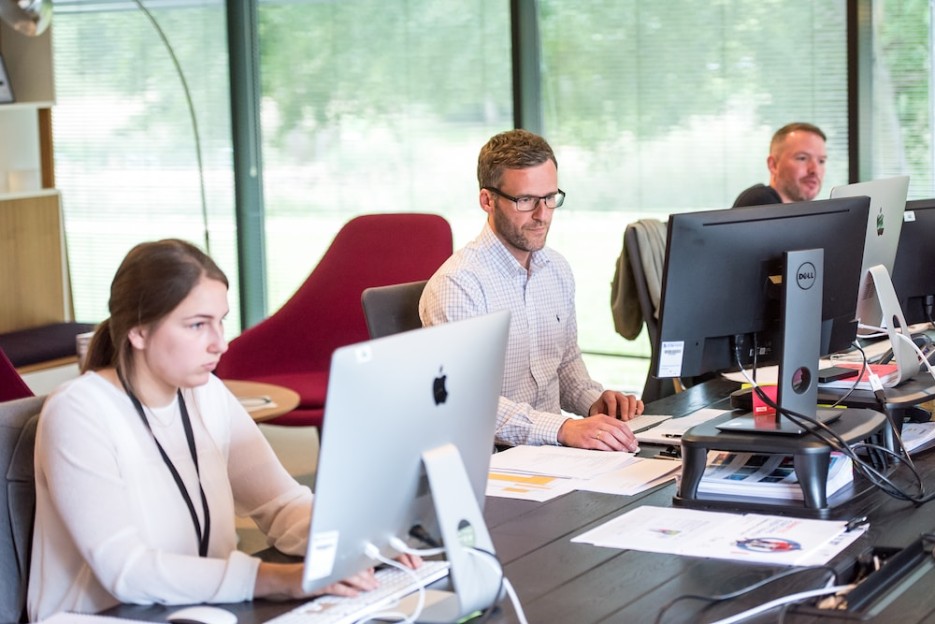
Maribeth Olafioye, founder of Change Management Library, is helping the next generation of business leaders develop their skillsets to bring transformative change to organisations.
With today’s shifting demands, change management has become a key component in helping businesses and organisations build future success.
Having experienced a lack of resources and training for leadership skills across a variety of industries seeking to transform themselves, Maribeth realised there was a growing need for education focused on change management.
From disruptive technologies to evolving business culture and processes, training for transformation and change management is helping the next generation of businesses lead their industries.
Discover in our exclusive interview how Maribeth launched Change Management Library, the benefits of learning about change management, how businesses and charities can approach transformation and what you can do to prepare for change.
In discussion with Maribeth Olafioye
Can you give us some insights into how you got started in the industry?
Maribeth: I kicked off my career as a Management Consultant at a Venture Capital Aspyre Group, specialising in Change & Transformation for CRM for Retail Clients. It was there that I managed the rollout of new CRM systems and helped clients in moulding their business strategies.
At heart, I’ve always been a people person with a strong inclination towards engagement. This quality truly came to the fore as I progressed to roles at the University of East London, establishing PMO governance in the professional services, followed by stints at organisations like Transport for London and the Department for International Trade.
Throughout my journey, I’ve been fuelled by my passion for instigating positive change, seeing it as a privilege to watch organisations evolve and flourish.
What is Change Management Library?
Maribeth: I founded Change Management Library in 2022 after noticing a distinct lack of easily accessible resources for individuals keen on pursuing a career in change management. Once I became a Change Practitioner, it became evident to me that there was a need for a more delivery-focused approach to change management that complemented project management effectively.
Change Management Library represents a passionate team committed to creating awareness about the pivotal role of change management in our constantly evolving world. Our primary offering is high-quality, virtual-led training sessions in Change Management, but we also host events to facilitate deeper engagements and discussions.
Our aim? To empower, educate, and establish Change Professionals, both on an individual and organisational level. Through our resources, we aspire to shape confident professionals who can navigate the challenges of tomorrow with assurance.
How can people benefit from learning about change management?
Maribeth: At its core, change management is about understanding, navigating, and leveraging change. In today’s fast-paced world, change is a constant, and learning about change management can offer several benefits:
- Personal Resilience: On an individual level, understanding change management helps people adapt to change more easily, building resilience. It provides tools and techniques to cope with shifts in one’s professional or personal life.
- Improved Communication: Change management places a strong emphasis on clear communication. Learning about it enables people to better articulate their ideas, concerns, or feelings during transitional periods, ensuring everyone’s on the same page.
- Stakeholder Engagement: For professionals, understanding change management means you know how to get buy-in from stakeholders. This is crucial for anyone in a leadership position or looking to climb the corporate ladder.
- Effective Implementation: Organisations often introduce new technologies, policies, or structures. Knowledge of change management ensures that these are not just introduced but are effectively implemented and adopted, leading to long-term success.
- Strategic Thinking: It encourages forward-thinking and planning, ensuring that individuals and organisations are proactive rather than reactive, positioning them ahead of potential challenges.
- Career Advancement: With businesses undergoing continuous change, professionals equipped with change management skills are highly sought after. It’s a skill set that can set one apart in job applications and promotions.
In essence, while change management might seem like a business-centric discipline, its principles are deeply human. Whether you’re navigating changes in your personal life or steering an organisation through a major transition, the skills and insights from change management are invaluable.
What would you say makes a successful business transformation?
Maribeth: That’s an insightful question, and one that’s at the heart of what we do at Change Management Library. From my perspective, several factors come together to drive a successful business transformation:
- Clear Vision and Strategy: First and foremost, there needs to be a clear vision of what the transformation aims to achieve. This vision should be supported by a well-defined strategy that outlines the path forward.
- Stakeholder Buy-in: Transformation is not a solo endeavour. It’s vital to have the buy-in and commitment from all stakeholders, from top leadership down to frontline employees. Everyone needs to understand and believe in the ‘why’ behind the change.
- Effective Communication: Throughout the transformation journey, transparent and consistent communication is crucial. People need to know what’s happening, why it’s happening, and how it impacts them.
- Adaptable Framework: While having a plan is essential, it’s equally crucial to be adaptable. The business environment is dynamic, and the ability to pivot and adjust to unforeseen challenges can make or break a transformation.
- Skilled Project Management: Efficient project management ensures that tasks are prioritized correctly, resources are allocated effectively, and timelines are met.
- Change Management Integration: This is close to my heart. Integrating change management ensures that the human aspect is considered. It’s about ensuring people are ready, willing, and able to support and participate in the change.
- Regular Monitoring & Feedback: Continuous monitoring of progress and actively seeking feedback can provide valuable insights. It helps in course correction if something isn’t working as planned.
- Celebrating Milestones: Recognising and celebrating small wins along the way can boost morale and maintain momentum. It reminds everyone involved of the progress made and the value of their contributions.
In essence, successful business transformation isn’t just about implementing new systems or processes; it’s about aligning people, processes, and technology towards a shared goal. When these elements come together, transformation not only takes place, but it sticks, ensuring long-term success.
How can change management be applied in the charity sector?
Maribeth: The charity sector, much like any other, undergoes change, whether it’s adapting to new regulations, responding to shifts in donor behavior, or embracing new technologies. Change management becomes crucial in ensuring these transitions are smooth and effective. Here’s how it can be applied:
- Understanding the Unique Culture: Charities often have a distinct culture driven by mission and values. Any change must respect and align with these core tenets. Change management helps to tailor approaches that fit this unique context.
- Engaging Stakeholders: In the charity sector, stakeholders range from donors, volunteers, beneficiaries, to staff. Effective change management ensures that all these groups are considered, consulted, and engaged in the change process.
- Resource Efficiency: Charities often operate with limited resources. Change management can help streamline processes, ensuring that changes are implemented efficiently without undue waste of time, money, or effort.
- Clear Communication: With diverse stakeholders involved, transparent and consistent communication becomes paramount. This ensures everyone is on board, understands the change, and is ready to support it.
- Capacity Building: Change management isn’t just about implementing a one-time change. It’s about building the capacity of the charity to handle future changes. This involves training, workshops, and ongoing support to develop internal champions of change.
- Beneficiary-Centric Approach: Any change in the charity sector should ideally enhance the value delivered to the beneficiaries. Change management ensures that their needs and feedback remain central to any transformation initiative.
- Embracing Technology: Charities, like many sectors, are increasingly leveraging technology, be it for fundraising, operations, or outreach. Change management can facilitate the smooth adoption of these technologies, ensuring that staff and volunteers are trained and comfortable with new systems.
- Feedback Loops: The charity sector thrives on feedback, be it from beneficiaries, donors, or internal teams. Change management establishes mechanisms to continuously gather this feedback, ensuring that the change remains relevant and effective.
In summary, while the principles of change management remain consistent, their application in the charity sector requires a sensitive, stakeholder-centric approach. With the right strategies, change management can empower charities to evolve, innovate, and amplify their impact.
What are some of the difficulties you see people facing when trying to deliver change?
Maribeth: Delivering change is rarely straightforward, especially in multifaceted organizational landscapes. Some of the challenges I’ve observed include:
- Difficult Project Sponsors: Change often requires champions, but when these champions – or project sponsors – are overly controlling or create blockers, it stifles progress. They might be resistant due to a fear of the unknown, or perhaps they feel the change might dilute their influence. Managing and navigating these personalities is crucial for successful change delivery.
- Organizational Politics: Politics can often overshadow the primary goals of a change initiative. People might resist change not because they believe it’s wrong, but because of the potential power dynamics at play. It becomes more about the players than the game.
- Hierarchical Structures: In deeply hierarchical organisations where power and control are central, driving change can be a challenge. Such environments often resist bottom-up ideas or feedback, which are essential for inclusive and comprehensive change.
- Poor Leadership: Leadership plays a pivotal role in change. Poor leaders can send mixed messages, fail to inspire trust, or simply not provide the direction needed. Without strong, consistent leadership, change efforts can become directionless or fragmented.
- Lack of Racial Diversity: A homogenous group is less likely to see the full spectrum of challenges and opportunities that a change initiative might present. Lack of racial diversity can mean missing out on varied perspectives, experiences, and solutions that a more diverse group might bring to the table. Plus, in today’s globalized world, it’s essential for organisations to be representative and inclusive.
- Resource Constraints: Whether it’s time, money, or manpower, resource limitations can strain change initiatives. Proper planning and prioritization become even more critical in such scenarios.
- Resistance to Change: This is a universal challenge. People are naturally resistant to change, especially when they don’t see the immediate benefits or understand the reasons behind it. Proper communication and engagement strategies can help alleviate this.
To navigate these challenges, it’s crucial to have a robust change management strategy in place, backed by a team that understands the nuances of organizational dynamics. It’s about balancing the technical aspects of change with the human side, ensuring that the transformation is not just effective but also inclusive and sustainable.
What are some of the steps organisations can take to prepare for a change?
Maribeth: A fantastic question! Preparing for change is all about having a structured approach that is both comprehensive and adaptable. At Change Management Library, we advocate for the CML 5Es model as a solid framework to guide this process.
Let me break it down:
- Explore: This is the foundational step where organisations need to fully understand the change they are about to undertake. This means analysing the current state, envisioning the desired future state, and identifying the gaps. It’s about asking the hard questions: Why is this change necessary? What are the potential challenges and opportunities? What impact will it have on the stakeholders?
- Enable: Once we understand the change landscape, the next step is to prepare the organisation. This is where assess the impacts, put in place the necessary resources, plans and support mechanisms. It’s about ensuring that the organisation has the right tools, training, and resources at its disposal.
- Engage: With the groundwork laid, the focus now shifts to the people. Change is successful only when everyone is on board. This phase is all about communication, consultation, and collaboration. Engage stakeholders, address their concerns, and involve them in the process. It’s about ensuring everyone feels a part of the journey.
- Emerge: As the change gets rolled out, the organisation begins to emerge into its new form. This phase is about monitoring, tracking readiness, and iterating. It’s crucial to track progress, gather feedback, and make necessary adjustments. Celebrate the wins, learn from the setbacks, and ensure the change is moving in the right direction.
- Embed: Last but not least, for any change to be sustainable, it must be deeply embedded into the organisation’s culture and operations. This means reinforcing the change through ongoing training, communication, and support. It’s about making the change a part of the organisation’s DNA.
The CML 5Es model is about ensuring a holistic approach to change. It complements existing frameworks, allowing organisations to seamlessly integrate it with their existing processes or other popular models like ADKAR. What makes it so effective is that it’s grounded in real-world experiences and best practices. So, for any organisation gearing up for change, using a tried and tested approach like the CML 5Es can be a game-changer.

How can we find out about your next virtual training session?
Maribeth: We have some wonderful sessions ahead with guest speakers. Our next virtual training on the Change Management – CML 5Es Course is slated for September 28th to 30th. And if those dates don’t work for you, we’ve got another session from October 26th to 28th. The standard investment for the training is £1200, but here’s a special treat for our listeners: you can get a 30% discount by using the code CML2015.
All the details and the registration process can be found on our website. I’m genuinely excited about these upcoming sessions and would love for as many as possible to benefit from them. Do join us and immerse yourself in the world of change management with a supportive community around you!
See Maribeth’s upcoming virtual-led training programmes to learn more.







